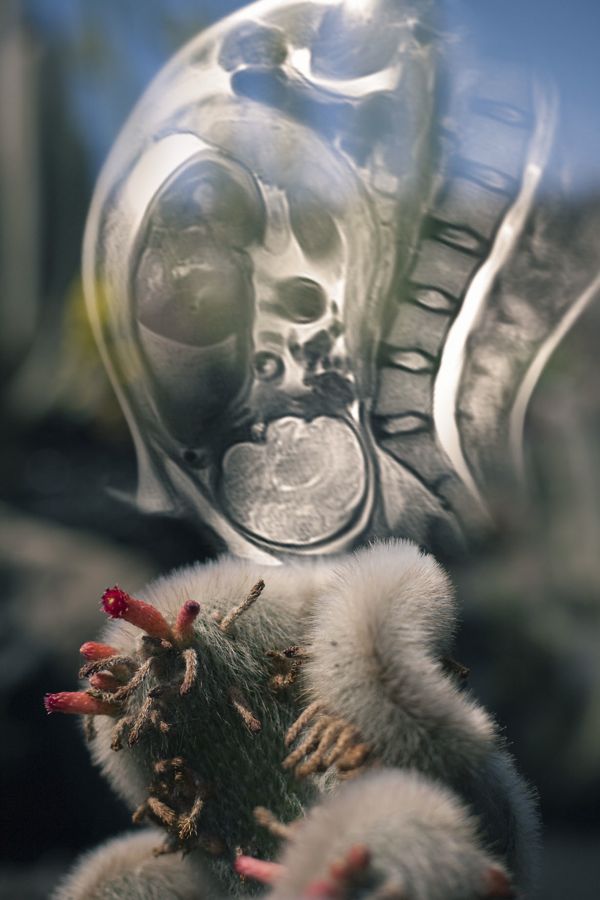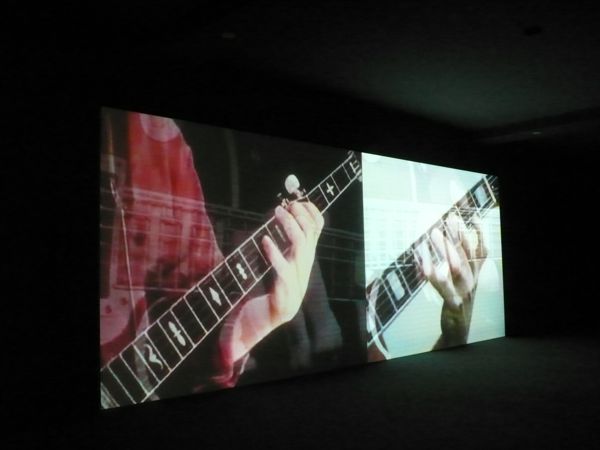Looking back at and consolidating the year in exhibitions is one of the more challenging tasks an art writer faces. Tracking trips to shows throughout the year, and more importantly, the evolution of your feelings about them, is a daunting, sometimes insurmountable task. While in Europe this spring and summer, I was lucky enough to view some of the exhibitions I found more momentous and personally resonant. Starting in Italy with the 54th Venice Biennale, I traveled up to Switzerland through Geneva and Basel, heading next to the UK and landing finally in Berlin. The list below reflects both personal favorites and those that I felt to be important in the confluence of art and technology.

Josephine Pryde, “Embryos and Estate Agents: L’Arte de Vivre” at Chisenhale, London
British artist Josephine Pryde bears the unique ability to successfully navigate both photography and sculpture, two mediums which seem almost diametrically opposed. Up until this year I’d only been familiar with Pryde’s sculptures of half-finished baskets precariously suspended by butcher hooks, shown at Galerie Neu in Berlin last year; as well as her strange, oversized macro photographs of fabric, featured at Reena Spaulings in 2009. For her presentation at Chisenhale, “Embryos and Estate Agents: L’Arte de Vivre,” Pryde presented two sets of photographs. The first takes medical images of fetuses, superimposing them in Photoshop against barren desert landscapes; the second stages stock photography-style portraits of young, alternative-looking women contemplating whether or not they’re pregnant. Beyond Pryde’s fascinating material practice is her confrontation of oft-taboo, extremely personal, female-specific issues generally elided in contemporary art discourse.

Cory Arcangel at the Whitney Museum of American Art, New York / Hamburger Bahnhof, Berlin
Arcangel Fever spread around early spring 2011 as his Whitney retrospective drew near, the artist being asked by a vertiginous number of New York media outlets to grace them with pre-opening press. The show sparked some lukewarm reviews, sometimes charged with being simplistic and failing to show enough older, canonized works, such as his Mario Clouds. In my eyes, Arcangel succeeded in what he does best: offering an exhibition both democratized and widely accessible as well as uncompromising in its subtextual historical references—not to mention trailblazing for the rest of us. Having one of the first major solo exhibitions as a tech-related artist in such a well-reputed institution as the Whitney, Arcangel continues to carve a path legitimizing new media and internet-related art practices in the eyes of the larger art world, and in my opinion, deserves hero status.

Murray Guy at Art Basel; Buckingham / Cesarco / Skaer
If we’re to look for successful, non-soul-crushing presentations within the ever-deplorable art fair setting, we needn’t look farther than the three-fold effort of New York-based gallery Murray Guy at Art Basel this year. Owned by Margaret Murray, Janice Guy, and directed by Jacob King, Murray Guy was afforded the (rather expensive) opportunity to show three of their artists within special projects at the Swiss fair. Both British artists Matthew Buckingham and Lucy Skaer showed immersive film and sculpture-based installations within Art Unlimited, and Uruguayan artist Alejandro Cesarco exhibited an installation-cum-slide presentation tying Conceptual art history with crime story narratives within Art Statements. For this presentation Cesarco won the much-coveted 30,000 Swiss Franc (32,000 USD) Baloises Art Prize. The New York-based gallery has a knack for working with artists who take both a studied conceptual approach and maintain aesthetic brilliance, and undoubtedly deserves such exposure.

Oliver Laric “Kopienkritik” at Skulpturhalle, Basel, Switzerland (Review)
No one really likes it when curators try to act as artists, yet strangely, the moment an artist curates an exhibition is generally lauded as their pinnacle of success. Existing between these two poles is Oliver Laric’s Kopienkritik, installed at Skulpturhalle Basel this summer. Kopienkritik, its title meaning “copy criticism” arranges similar-looking Greek statues and Roman copies from the Skulpturhalle’s collection to track the lineage and development of a sculptural style or pose. With independent curator Raffael Dörig, Laric interspersed his own sculptural work and video within his presentations of the museum’s collection. Strange here is the tenacity Laric shows for navigating the politic of the image while simultaneously working with that of the museum collection. Laric’s multitasking, internet-aware sensibility is one desperately needed—and perhaps increasingly sought—in the contemporary art world.

Rhododendron, curated by Harm van den Dorpel at W139, Amsterdam / SPACE London
Over the last couple years, a curious phenomenon has become a reality for the vaguely defined, amusingly insular community we call the “internet art world,” one that has many of its denizens up in arms: artists who once worked solely online have trickled offline and into the “IRL” art world, trading in code for paint and plaster. Needless to say, this shift toward material practices has been met with a surfeit of cynicism, with accusations of elitism and selling out circulating the web—in a more favorable breath, this phenomenon has only been described with head-shaking confusion. Rhododendron, curated by Dutch artist Harm van den Dorpel, brazenly celebrates the collective march toward working through sculpture, painting, and collage, proffering that working through such means doesn’t necessitate market complacency, but rather signifies growing curiosity for parsing out ideas through medium-specific material in addition to software. Originally installed at W139 Amsterdam, Rhododendron features the work of van den Dorpel, Juliette Bonneviot, Charles Broskoski, Martijn Hendriks, Joel Holmberg, and Marlie Mul. The exhibition was brought to London’s [SPACE] by curator Paul Pieroni in the autumn of 2011.

Ben Schumacher within “Short Stories” at SculptureCenter, New York
Curated by Isla Leaver-Yap, “Short Stories” brings together several underappreciated young New York-based artists whose work should be considered some of the most preeminent in the city—Iman Issa, Alejandro Cesarco (mentioned above), Danna Vajda, and Ben Schumacher. Yet Schumacher, who recently graduated from New York University’s MFA program, hit this one out of the park. His installation within the SculptureCenter’s basement—forever the bane of artists working with this dungeon-like space—responded aesthetically to its dinge, pipes and aqueducts. And compellingly, as compared to some self-professed “lifers,” Schumacher only fairly recently decided to commit to being an artist full-time, having completed an undergraduate degree in architecture. Yet, one can gather that architecture never left Schumacher, and that a highly aesthetic and curious artistic tendency had been omnipresent in him as a person—this equation combined with the SculptureCenter space struck pure gold. Tellingly, a previous curator of the SculptureCenter said it was among the best installations in the space that she had ever seen. I undoubtedly agree with her.

Based in Berlin, various locations, Berlin, Germany
It’s difficult to really like Based in Berlin, for all its uneven presentation and, at times, shoddy installation, yet the citywide survey deserves credit for supporting several Berlin-based artists who had yet to be institutionally recognized. Taking place at five venues throughout the city, Atelierhaus Monbijoupark, KW Institute for Contemporary Art, Hamburger Bahnhof, Neuer Berliner Kunstverein, and the Berlinische Galerie, Based in Berlin celebrated artists I’d been tracking for years, from the well-known Simon Denny and Klara Lidén to the more emerging Juliette Bonneviot and Helga Wretman. Based in Berlin also introduced me to artists in the Berlin scene such as Nicolas Ceccaldi, Yngve Holen, and Ilja Karilampi, many of which worked with young Swiss curator Fredi Fischli, one of the survey’s five curators.

Mark Leckey "See, We Assemble" Serpentine, London / Gavin Brown, New York
While Mark Leckey is deservedly a big deal in the UK, winning the Turner Prize in 2008, I’d argue he’s not nearly a big enough deal in New York, performing here about once a year or less. Last winter saw “GreenScreenRefrigeratorAction” a strange, synchronized performance with a sleek refrigerator against a kelly green background. A mixture of an advertisement and theatrics, Leckey communicates with the smart fridge, to which he becomes closer via the anxiety-inducing stunt of inhaling refrigerator coolant. This performance, as well as scores of appropriated appliances standing in as sculptural objects, comprised his solo exhibition at the venerated Serpentine in London earlier this year. Here’s hoping he receives a museum solo in New York.

Various Transmitters, Renwick Gallery, New York, curated by Maxwell Graham
Curator Maxwell Graham is curiously adept at scouting the talent of young artists around New York and across Europe. Many included inVarious Transmitters, an exhibition meditating on the evolving methods of information transferal from the TV to the internet, had been rarely if ever shown in New York. Included is Berlin-based New Zealander Simon Denny, who 10 months later enjoyed his first solo show in Manhattan, which just closed at the well-renowned Friedrich Petzel. Various Transmitters, installed at New York’s Renwick Gallery, also featured the work of Bernadette Corporation (their stand-out upscale chrome bathroom fixtures etched with anonymous online comments responding to leaked Rhianna cell phone nudes), Lutz Bacher, and Mandla Reuter. Graham, once director of the Soho-based Renwick, now directs a new gallery of his own, Essex St, whose 2012 programming is not to be missed.

James Richards, Haroon Mirza, Ed Atkins at the Zabludowicz Collection, PERFORMA
New York in early November was abuzz with talk about the enigmatic collaboration between Brits James Richards, Haroon Mirza (a stand out at the Venice Biennale this year), and Ed Atkins located at the Zabludowicz Collection in Times Square. What exactly the performance consisted of, no one was quite sure, though it certainly had something to do with taking over the LED signs in Times Square. A project for Performa, the collaboration saw Richards, Mirza, and Atkins install their own sculptural work within the raw, somewhat industrial looking, glass-windowed space of the Zabludowicz Collection overlooking the busy midtown intersection. Guests were invited to climb to the Collection’s 33rd floor space for an hour at nightfall, overlooking the Times Square signs programmed with videos relating to the work inside. The oddly synchronous installation was truly spectacular, in the best sense of the word.
Honorable Mentions (or shows I unfortunately missed):
- Artie Vierkant at China Art Objects, LA
- Petra Cortright "So Wet" at Preteen, Mexico City
- Collect the WWWorld curated by Domenico Quaranta, Milan
- James Richards at Chisenhale, London
- Laure Prouvost at MOT International
- Jodi’s performance as part of “Highways Connect and Divide” at Foxy Production
- Christian Marclay's "The Clock" Paula Cooper, LACMA, The 54th Venice Biennale, etc.
- Ryan Trecartin at PS1, NY
- Lucky PDF’s “Lucky PDF TV” for Frieze Projects